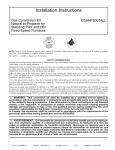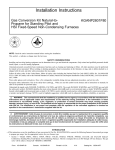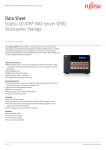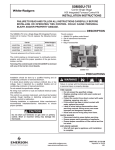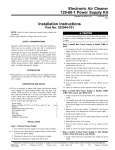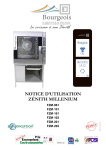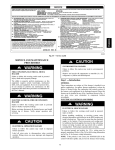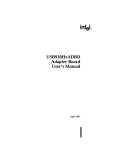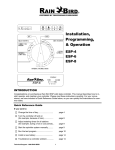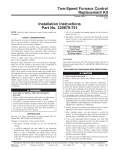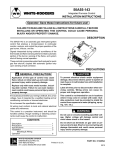Download Carrier 58DHC Instruction manual
Transcript
Fixed Speed Furnace Control Replacement Kit Cancels: New IIK 349M-50-1 9-98 Installation Instructions Part No. CESO110057-02 NOTE: Read the entire instruction manual before starting the installation. SAFETY CONSIDERATIONS Installing and servicing heating equipment can be hazardous due to gas and electrical components. Only trained personnel should install or service heating equipment. Untrained personnel can perform basic maintenance functions such as cleaning coils, or cleaning and replacing filters. All other operations should be performed by trained service personnel. When working on heating equipment, observe precautions in the literature, on tags, and on labels attached to the unit. Understand the signal words DANGER, WARNING, and CAUTION. These words are used with the safety-alert symbol. DANGER identifies the most serious hazards which will result in severe personal injury or death. WARNING signifies a hazard which could result in personal injury or death. CAUTION is used to identify unsafe practices which would result in minor personal injury or product and property damage. NOTE is used to highlight suggestions which will result in enhanced installation, reliability, or operation. The ability to properly perform service on this equipment requires certain expertise, mechanical skills, tools, and equipment. If you do not possess these, do not attempt to perform any service on this equipment other than those procedures recommended in the User’s Manual. A failure to follow this warning could result in possible damage to this equipment, serious personal injury, or death. INTRODUCTION Circuit board Part No. CESO110057-02 is a direct replacement for circuit boards Part No. CESO110057, CESO110057-01, CESO110057, CESO110048, CESO110020, and HH84AA016. This revised circuit board has incorporated LED diagnostics as an aid in troubleshooting. It is recommended that a sight glass (not included) be installed in a convenient location on the furnace, see Optional Section. If a sight glass is not installed, the self-test feature of the board can still be used for routine troubleshooting. The fault code label provided must be installed on the furnace. Major changes to the operation of this control include: 1. A 90 sec blower on delay if power is restored during a call for heat. 6. The inducer will run continuously during the self-test cycle. 7. Nominal flame sensing current is between 4.0 to 5.0 microamps (uA) DC. On twinned furnace applications, the CESO110057-02 board will work with any of the above listed circuit boards and a CESO110005 twinning control module. NOTE: On twinned applications, the short jumper wire between pins ST-2 and 225 MUST be removed from remaining circuit board. Failure to do so will result in incorrect ignitor warm up times and nuisance furnace lockouts. ELECTROSTATIC DISCHARGE (ESD) PRECAUTIONS CAUTION: Electrostatic discharge can affect electronic components. Take precautions during furnace installation and servicing to protect the furnace electronic control. Precautions will prevent electrostatic discharges from personnel and hand tools which are held during the procedure. These precautions will help to avoid exposing the control to electrostatic discharge by discharging static electricity build-up to ground. 1. Disconnect all power to the furnace. DO NOT TOUCH THE CONTROL OR ANY WIRE CONNECTED TO THE CONTROL PRIOR TO DISCHARGING YOUR BODY’S ELECTROSTATIC CHARGE TO GROUND. 2. Ground yourself by touching your hand and tools to clean, unpainted, metal surface of furnace. close to control. 3. After touching chassis, you may proceed to service the furnace. You will recharge your body with static electricity by moving about or shuffle your feet. Reground yourself. 4. If you touch ungrounded objects (recharge your body with static electricity), reground yourself. Use this procedure for installed and uninstalled (ungrounded) furnaces. 5. Ground yourself again before handling a new control to protect control from damage. If control is to be installed in furnace, follow items 1 through 5 again before installing control. Put all used AND new controls into containers before touching ungrounded objects. 6. An ESD service kit (available from commercial sources) may also be used to prevent ESD damage. Step 1—Removal of Existing Control 2. The ignitor warm-up time is fixed at 17 sec. 3. The furnace will recycle if pressure switch opens and re-closes during a call for heat. 4. If limit switch opens 4 times during a call for heat, circuit board will lockout the furnace for 3 hr before resetting. 5. Blower off delay jumper has been replaced with DIP switches. Label all wires prior to disconnection when servicing controls. Wiring errors can cause improper and dangerous operation. 1. Turn thermostat to OFF or set temperature to the lowest setting. Manufacturer reserves the right to discontinue, or change at any time, specifications or designs without notice and without incurring obligations. Book 1 4 PC 101 Catalog No. 535-715 Printed in U.S.A. Form 58DHC-6SI Pg 1 9-98 Replaces: New Tab 6a 8a 2. Turn off electrical supply to furnace. current. Nominal flame current is between 4.0 and 6.0 microamps DC. If flame current is below 4.0 microamps DC, remove and clean flame sensor with fine steel wool, or replace flame sensor. The furnace control will lock-out when flame current falls to 0.5 microamps DC. 3. Turn off gas supply to furnace. Failure to turn off the gas and electric supply may result in explosion, fire, death or personal injury. Step 3—System Operation 4. Remove furnace blower and control access doors. 1. Perform any other safety checks as deemed necessary (flame safety, limit switch, vent system etc.). 5. Remove control box cover. 2. Run unit through 1 complete call for heat cycle. 6. Disconnect thermostat and humidifier (if equipped) wires. OBSERVATION PORT/SIGHT GLASS INSTALLATION (OPTIONAL) NOTE: If a sight glass is not installed, current fault code will be erased when blower door is removed. 7. Disconnect line voltage, blower, EAC, (if equipped) and transformer wires. 8. Remove wiring harness edge connector and gasket from circuit board. Replacement furnace control Part No. CESO110057-02 has LED fault code capability. To utilize this feature, it is necessary to field install a sight glass or observation port. The location of this device will vary depending on the model of the furnace. 9. Remove retaining screws and old circuit board. 10. Inspect control and control box for evidence of water staining. 11. Correct any sources of water leakage (humidifier, evaporator coil, vent system) into the control area. Step 1—Upflow Condensing Furnaces With the blower door(s) removed, locate the LED on the control board. Check the sides of the casing. You may be able to utilize the unused condensate drain opening or electrical knock-out as an observation port on some models. A 1/2-in. electrical box knockout plug must be installed when this option is used. Step 2—Installing the New Control 1. Ground yourself! Handle circuit board by edges. 2. For 90 percent efficient furnaces, clip JW9 jumper wire. JW9 jumper is located near right-hand corner of circuit board below HUM-1 terminal. (See Fig. 1.) This will provide 15 sec inducer off delay. Step 2—All Furnaces 3. Insert edge of board between tabs of control box. 1. Measure height of LED off the floor for upflow furnaces or off the blower shelf on downflow/horizontal furnaces. 4. Install circuit board retaining screws. 2. Then measure distance from front inside edge of casing. 5. Connect all line-voltage, low-voltage, and accessory wires. 6. Connect wiring harness edge connector to circuit board. 3. Orient blower door to correct position and mark this location on front of blower door. 7. Set blower off delay. Blower off delay DIP switch SW1 is located near right-hand corner of board. (See Fig. 1.) 4. Using a step-drill or chassis punch, drill 1 1/2-in. hole in blower door. 8. Re-install control box cover. 5. Install a sight glass Part No. 323017-201 or 323018-201 in blower door. 9. Do not connect thermostat wires to control board until Start-up and System Check-out is complete. 6. A 1/2-in. hole may be drilled and an electrical box plug may be used and are available from hardware stores or electrical suppliers. SYSTEM CHECK-OUT Step 1—Component Self Test NOTE: Do NOT install an observation port or sight glass through warning labels on furnace. If a warning label interferes with the observation port, use an alternate location such as side of casing. 1. To initiate component test sequence, ensure thermostat is turned OFF or thermostat wires are disconnected. Turn power on and engage blower door switch. With a short piece of wire, briefly short TEST/TWIN terminal to Com/24v terminal. Component test sequence is as follows: Or, a 1/4-in. hole may be drilled in blower door and then plugged with a 5/16- X 1/2-in. long screw providing it does not interfere with instructions or control board. a. Status LED will flash code then turn ON inducer motor. b. Inducer motor will run for entire component test. 7. A loose fitting sight glass should be sealed with clear silicone to prevent leakage and sight glass from falling out. c. Hot surface ignitor and blower motor-heat speed will run for 10 sec. 8. Install Fault Code label (see Fig. 2) in a convenient location on blower door adjacent to sight glass. d. Blower motor-cool speed will be turned on for 10 sec. 2. Repair or replace or service any component that fails during the self-test. The gas valve is not energized during self-test. Do not install a sight glass or observation port between the blower compartment and the furnace vestibule. Do not cover any port with tape. Do NOT run the unit unattended with the blower door off. Carbon Monoxide may be drawn into living space. A failure to follow this warning could result in possible damage to this equipment, serious personal injury, or death. 3. Turn power off. 4. Disengage blower door switch. 5. Connect thermostat wires. 6. Install blower and access doors. 7. Turn power back on. 8. Turn on gas. Step 2—Flame Sensor Operation Connect a DC microammeter in series with flame sensor. Initiate a call for heat. After burners ignite and stabilize, measure flame 2 C7 R15 R17 (TP1) JW18 R39 R40 R13 HUM-1 C6 J21 R26 R30 90 135 180 225 R19 JUMPER 9 UNCUT: 5 SEC., CUT: 15 SEC. JW9 R21 INDUCER OFF DELAY J16 JW17 1 2 SW1 TEST/TWIN BLOWER-OFF DELAY SWITCH SETTING A98511 Fig. 1—Part of Control Board 3 SERVICE LED CODE CONTINUOUS OFF CONTINUOUS ON RAPID FLASHING - STATUS Check for 115VAC at L1 and L2, and 24VAC at SEC-1 and SEC-2. Control has 24V power. Line voltage (115V) polarity reversed. If twinned, refer to twinning kit instructions. EACH OF THE FOLLOWING STATUS CODES IS A TWO DIGIT NUMBER WITH THE FIRST DIGIT DETERMINED BY THE NUMBER OF SHORT FLASHES AND THE SECOND DIGIT BY THE NUMBER OF LONG FLASHES. 11 NO PREVIOUS CODE - Stored status codes are erased when power (115V or 24V) to control is interrupted or 48 hours after each fault is cleared. 12 BLOWER ON AFTER POWER UP (115V or 24V) - Blower runs for 90 seconds, if unit is powered up during a call for heat (R-W closed). 13 LIMIT OR FLAME ROLL-OUT SWITCH LOCKOUT - Auto reset after three hours. For flame roll-out switch or fuse link, refer to #33. 14 IGNITION LOCKOUT - Control will auto-reset after three hours. Refer to #34. 21 GAS HEATING LOCKOUT - Control will NOT auto reset. Check for: - Stuck gas valve relay on control or miswire to gas valve circuit. 22 ABNORMAL FLAME-PROVING SIGNAL - Flame is proved while gas valve is de-energized. Inducer will run until fault is cleared. Check for: - Stuck-open gas valve or leaky gas valve. 23 PRESSURE SWITCH DID NOT OPEN Check for: - Obstructed pressure tubing. - Defective pressure switch (stuck closed). 24 SECONDARY VOLTAGE FUSE IS OPEN Check for: - Short circuit in secondary voltage (24V) wiring. 31 PRESSURE, DRAFT SAFEGUARD, AUXILIARY-LIMIT (when used), OR BLOCKED VENT SHUTOFF (when used) SWITCH DID NOT CLOSE OR REOPENED - If open longer than five minutes, inducer shuts off for 15 minutes before retry. Check for: - Proper vent sizing and condensate pitch - Inadequate Combustion air supply. or sag. - Low inducer voltage. - Vent restriction or high winds. - Disconnected or obstructed - Defective inducer motor or start capacitor. pressure tubing. - Defective pressure switch or connections. If it opens after trial for ignition period, blower will come on for 90 second recycle delay. 33 LIMIT OR FLAME ROLL-OUT SWITCH IS OPEN - If open longer than three minutes,code changes to #13. Check for: - Defective blower motor or start capacitor. - Dirty filter or restricted duct system. - Loose blower wheel. - Defective switch or connections. - Inadequate Combustion air supply Flame Roll-out Switch or fuse link. - Open Flame Roll-out switch,or fuse link. Manual reset or replace. 34 IGNITION PROVING FAILURE - Control will try three more times before a lockout #14 occurs. If flame signal lost after trial for ignition period, blower will come on for 90 second recycle delay. Check for: - Oxide buildup on flame sensor (clean with fine sandpaper). - Proper flame sense microamps (.5 microamps D.C. minimum). - Gas valve turned off. - Manual shut-off valve. - Low inlet gas pressure. - Green wire MUST be connected to furnace sheet metal. - Inadequate flame carryover or rough ignition. COMPONENT TEST To initiate the component test sequence,shut OFF the room thermostat or disconnect the "R" thermostat lead. Briefly short the TEST terminal to the ’Com 24V’ terminal. Status LED will flash code and then turn ON the inducer motor. The inducer motor will run for the entire component test. The hot surface ignitor, blower motor-heat speed, and blower motor-cool speed will be turned ON for 10-15 seconds each. LED W Y R Com 24V TEST / TWIN G 997-420001-1 A98512 Fig. 2—Service Label for LED Code Copyright 1998 Carrier Corporation 349m501 Manufacturer reserves the right to discontinue, or change at any time, specifications or designs without notice and without incurring obligations. Book 1 4 PC 101 Catalog No. 535-715 Printed in U.S.A. Form 58DHC-6SI Pg 4 9-98 Replaces: New Tab 6a 8a




